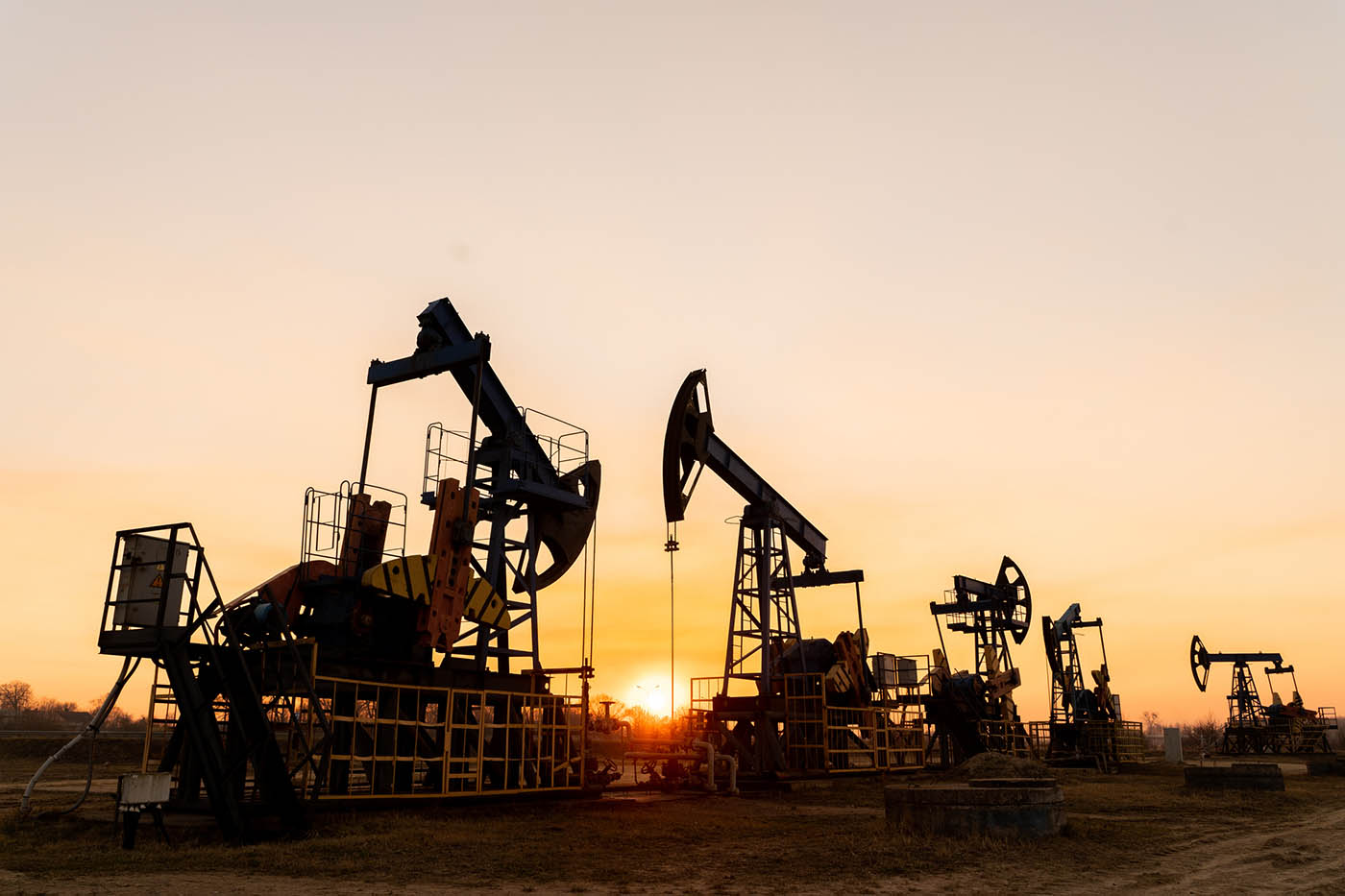
As climate change escalates, the transition toward clean energy and sustainable transportation has never been more critical. But it will introduce new risks. This article focuses on a core component of the transition: the indispensable minerals used for batteries, wind turbines, solar panels and other decarbonization technologies (“transition minerals”).
Ironically, one of the most unrecognized risks for transition minerals is the speed and severity of climate change impacts. Our analysis suggests the next decade is poised for significant shifts in extreme weather. We are concerned these have been underestimated because of the emphasis on consensus average estimates and we think a large majority of companies, investors and governments are wholly unprepared.
Climate scientists are increasingly persuaded that we will reach 1.5°C of average global warming by the end of this decade, after passing 1°C of warming in 2017. Initial analyses from our datasets suggest this will entail an average 131% global increase in days spent over 2017’s 95th temperature percentile, with certain regions experiencing increases up to 525%.
Lou Munden
In collaboration with the IBS Center for Climate Physics at Pusan National University (ICCP) and with support from the Hewlett, Quadrature Climate and V. Kann Rasmussen Foundations, our organization the TMP has worked to develop publicly available datasets to provide more granular climate information for the next decade’s extreme weather events. Extreme weather events, or EWEs, are defined as unusual weather conditions triggered by significant changes in one or more climate indicators measured by temperature and precipitation.
This research has focused on physical climate changes, which will likely have a cumulative impact by exacerbating conflict, natural resource scarcity, logistical challenges and political instability. The resulting cumulative climate risks could drive widespread supply chain disruption, large financial losses and significant negative externalities (e.g. damage to livelihoods and biodiversity).
These cumulative climate risks can be managed through urgent, targeted and concerted action to build supply chain resilience. Once alerted to cumulative climate risks, key decision-makers must move to avoid and mitigate them or to adapt to them when necessary. Indeed, climate risks can motivate improvements in the mining sector (e.g. in water management and community engagement) which have been needed for decades.
Climate Impacts on Transition Mineral Supply Chains
The energy transition requires rapid, unprecedented, expansion of assets — such as mines, processing plants, manufacturing facilities and logistical infrastructure — and supply chains for several key minerals, including copper, nickel, lithium, graphite, cobalt, manganese, rare earth elements and platinum group metals. Production, processing, and transportation of key materials must increase by 229-527% by 2030 according to different projections.
Ben Bowie
For companies from most OECD countries, this kind of increase in supply is difficult due to years of underinvestment in exploration and because the sector is beset by social and environmental challenges endemic to the industry, for which businesses are typically unprepared. Similarly, Chinese companies face obstacles due to decreased investments in overseas exploration in the 2010s and the knock-on effects of China’s current economic crisis. Our data suggests increasing climate risks could further hamper a rapid expansion of access to transition minerals.
Mineral extraction and processing are highly geographically concentrated — a few countries and areas dominate key commodities. For example, one site in Chile and another in Australia account for over 50% of recent global lithium production. Also, most minerals are largely — some almost exclusively — processed in China.
Therefore, to understand the importance of climate impacts, our initial analysis has identified 35 level-one administrative areas — for example, state level (U.S.) or province level (China) — responsible for a significant proportion of transition mineral production and processing. These include lithium (90%), cobalt (71%), flake graphite (60%), rare earth elements (55%), manganese (44%), nickel (40%) and copper (29%). Table 1 shows the initial cumulative climate risk results for these areas, while Figures 1-3 break down the results according to “temperature”, “high rainfall” and “low rainfall” impacts.
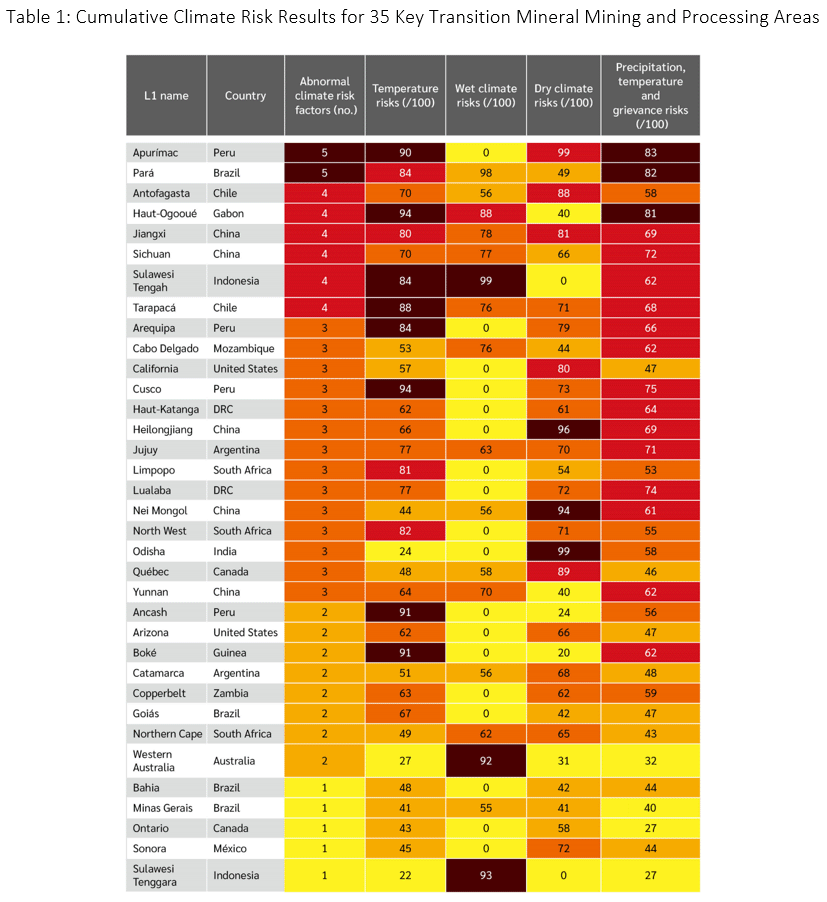
The geopolitical risks created by this supply chain concentration are well known, but our data suggests these areas are also particularly exposed to extreme weather events. Specifically, 25% of these key areas are unusually exposed (60th to 80th percentile) to at least one EWE, 23% are very exposed (80th to 90th percentile) and 46% are extremely exposed (above the 90th percentile). Multi-hazard events are also a significant risk, with 69% of key areas unusually exposed to two or more EWEs.
Extremely exposed areas produce almost 75% of the world’s platinum, over 25% of lithium and nickel and over 20% of copper, implying potentially significant consequences for transition mineral production and processing.
Justin Muhl
Global Exposure to Extreme Weather Events
A breakdown of the risks posed by different EWEs illustrates the possible impacts of climate change for transition mineral assets (mines, processing plants, manufacturing facilities or logistical infrastructure). We have developed analytical algorithms to assess the change in various EWEs globally at 1.5°C (~2029) compared to the level at 1°C of warming (~2017).
Working with collaborators at ICCP, the algorithms run across 20 climate models using their Aleph supercomputer, each generating specific estimates of change in EWEs. These are then combined and weighted to produce the results below. Our analysis focuses on where different climate models most strongly agree that shifts in EWEs will be high. This section presents preliminary results, together with explanations of why the EWEs matter for mining or processing of transition minerals.
Temperature: Combining two indicators — extreme temperature and unseasonably high temperature - we find that many assets in places like Brazil, Peru, South Africa and China will see operations disrupted (see Figure 1). Without adequate preparation, this will potentially impact the availability of copper, manganese, graphite and lithium (among other key minerals).
Extreme heat can prevent people from working safely in mines and processing facilities and can damage equipment and infrastructure (e.g. buckling rail lines). Also, evidence shows that temperature increases are correlated with rising likelihoods of conflict and dispute.
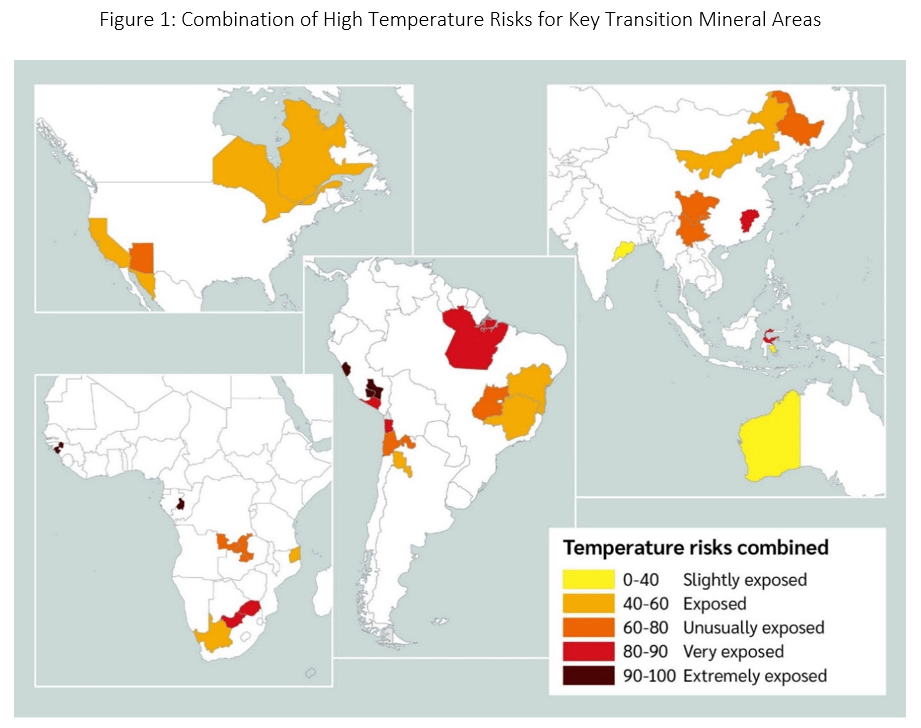
Water risks: Flooding from increased and extreme rainfall can shut down mines and, more problematically, lead to tailings dam failures that have substantial social, environmental and political repercussions (explored in the next section). More water also complicates mine dewatering and can slow processing, particularly for evaporation-based methods.
Most mines and processing facilities are designed for historical precipitation patterns and flooding events, not those we expect in the next few years. Figure 2 shows the combined effect of consecutive wet days with unseasonably wet periods. For example, historically dry areas of Western Australia are extremely exposed to becoming much wetter.
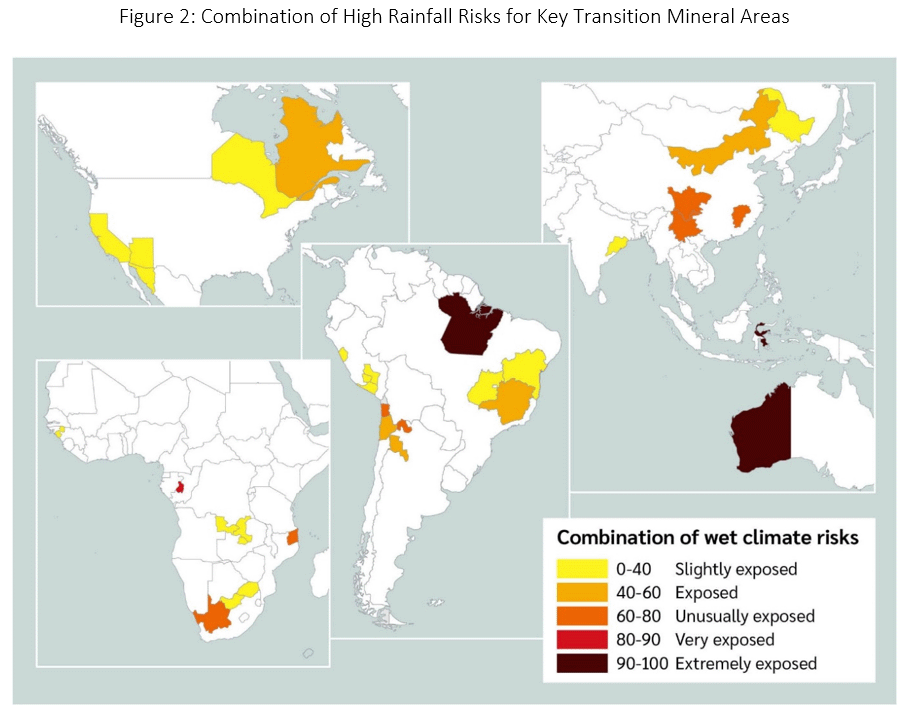
Unusually low rainfall also brings risks, as transition mineral assets are typically thirsty — using water for excavation, tailings management and washing. Chilean mines, for example, have been forced to invest heavily in desalination due to decreased rainfall. Some facilities obtain power from hydroelectric dams, whose output is regularly disrupted during dry periods. Along with operational impacts comes increased competition for reduced water supplies and so greater local opposition to mining operations. Figure 3 illustrates areas at risk of low rainfall.
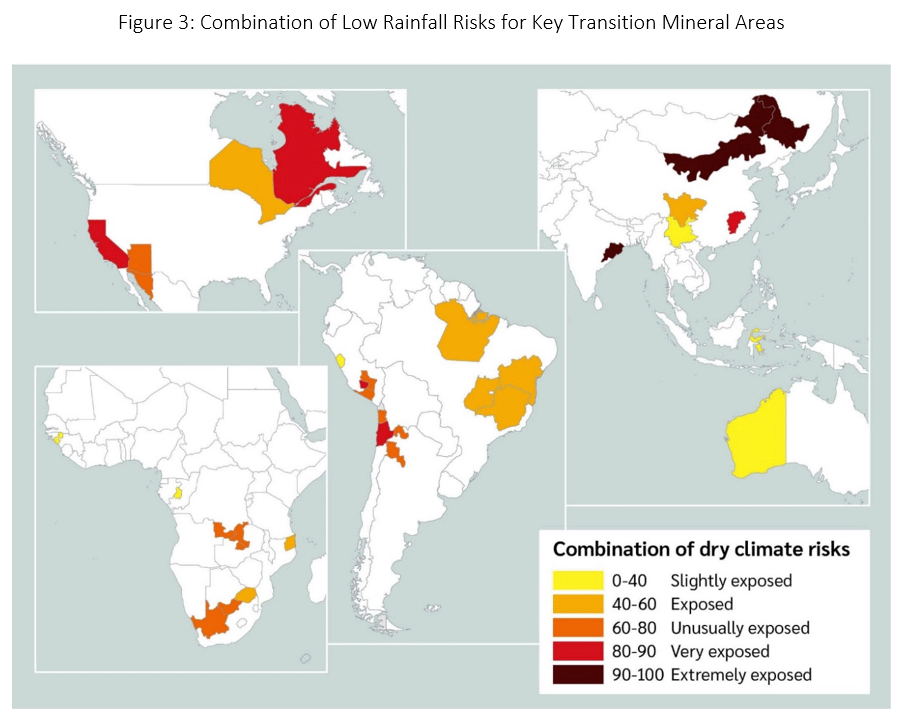
Multi-hazard risks: These new patterns of extreme weather are not isolated. Many key areas will experience multiple EWEs that are likely to contribute to interconnected and chronic challenges, which further increases the likelihood of disruption from physical climate impacts. Figure 4 shows that many key areas face near-term exposure to multi-hazard/abnormal risks.
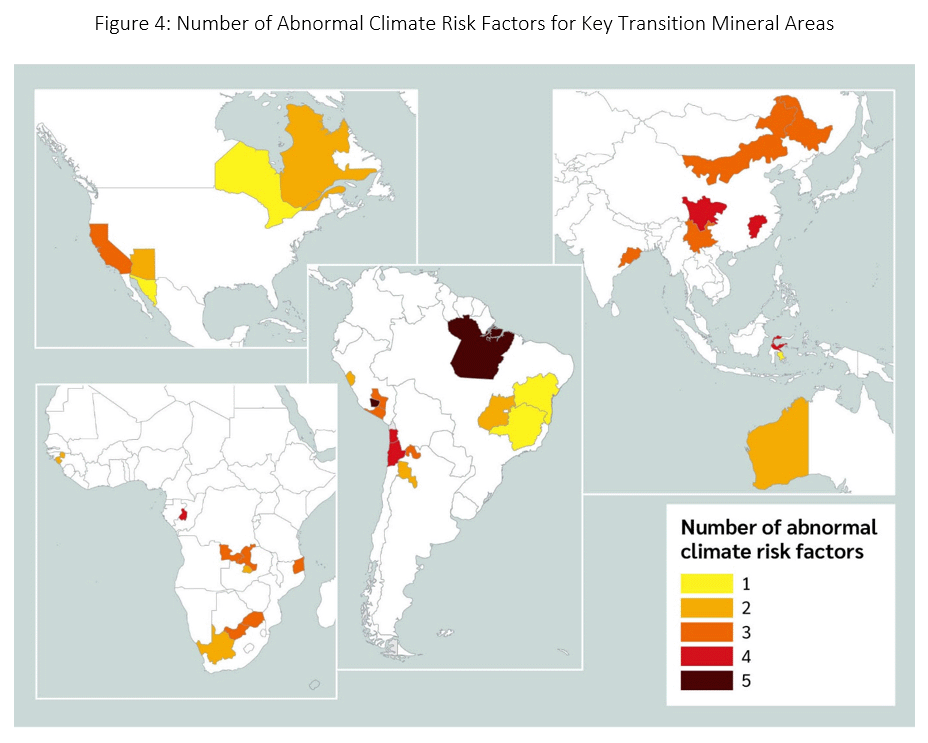
Extreme Weather Events Exacerbate ESG Challenges
Along with direct effects, EWEs have important cumulative impacts, most notably involving interactions with existing environmental, social, and governance (ESG) risks — already the most significant challenge the mining sector faces.
In particular, loss of social license to operate can create serious problems for existing mining projects, leading to production disruptions and even cancellation. For example, the Cobre Panama project — one of the world’s largest open pit copper mines — had its license suspended in 2023 following protests over its impact on water resources and the way that its benefits have been distributed. There are hundreds of similar disputes across the world.
Using our Landscope tool — which examines factors like water, land use, corruption, governance quality, poverty, inequality and access to basic services — alongside our combined climate risk data, we find that 17% of key areas are at least unusually exposed, 40% very exposed, and 9% extremely exposed to cumulative climate and social/grievance risks (Figure 5). These areas account for significant proportions of global production for platinum (70%), cobalt (68%), flake graphite (60%), lithium (38%), copper (32%) and rare-earth elements (32%).
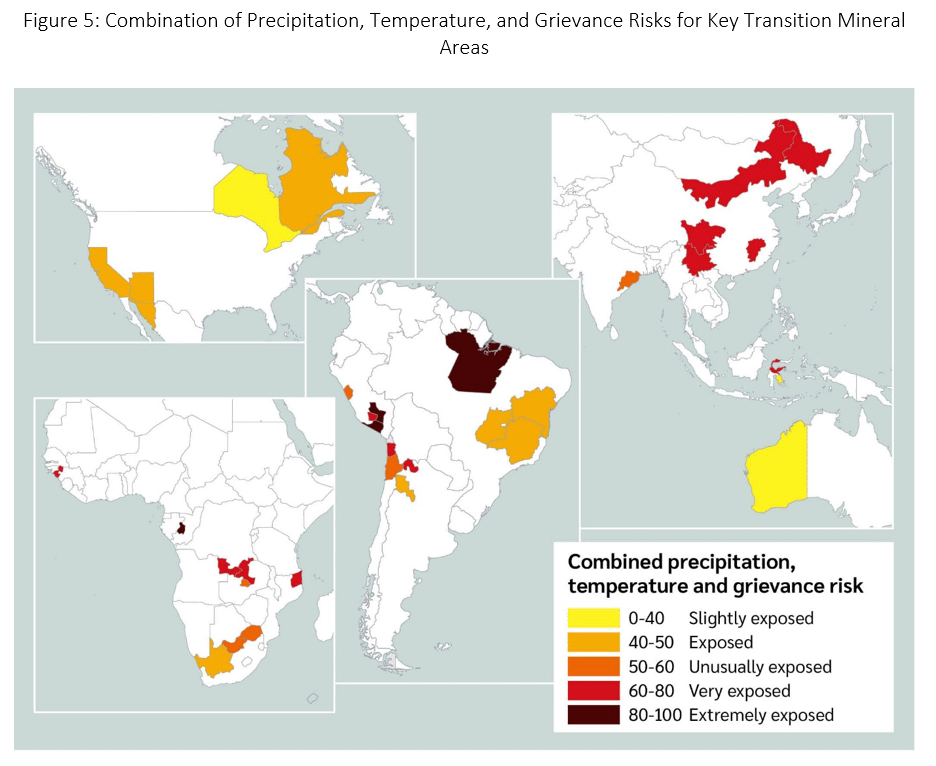
Not only are significant areas exposed to both social and climate issues, many of the most serious ESG challenges for the mining industry (Figure 6) are exacerbated by prevalent and severe climate impacts.
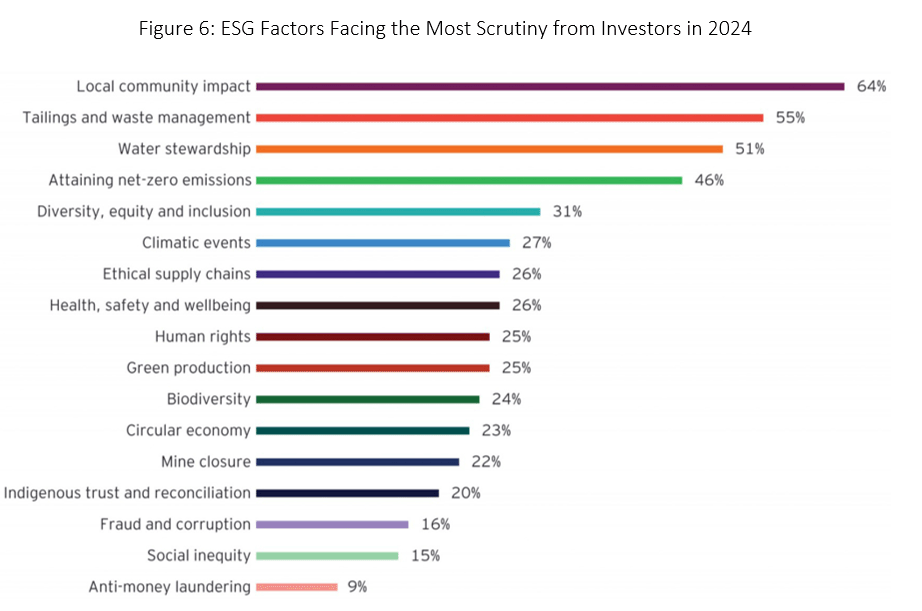
Source: EY mining and metals business risks and opportunities survey data 2024
We describe three significant problematic interactions, with the most serious ESG challenges in bold.
Extreme temperatures lead to increases in the rate of conflict, making local community support harder to win and maintain. This risk is likely highest where trust between the industry and local communities (including indigenous groups) is already low and where there is a history of dispute. This already occurs in some critical areas for mine expansion, including Peru (copper), Mozambique (graphite) and Indonesia (nickel).
Extreme rainfall and long wet periods could impact thousands of legacy tailings ponds that were not engineered for this much precipitation. Failures, like the Brumadinho disaster, which killed at least 270 people and harmed health and biodiversity across the Amazon basin, will become much more likely in places with a long history of mining, including Chile (lithium, copper), the Democratic Republic of the Congo (DRC) (cobalt, copper) and Australia (lithium, copper, rare earth elements and others).
Unseasonal dryness and associated drought will create further challenges for water stewardship and local access to water, which is a human right. Vulnerable groups will likely be most impacted, aggravating social inequity. By limiting access to hydropower, droughts could disrupt production and processing in countries like Canada, the U.S. and Russia. China’s experience shows that these gaps are likely to be plugged with coal, hindering net-zero emissions.
Country-Level Risks Increase in Times of Extreme Weather
Besides these mostly local ESG challenges, our work also highlights macro-level risks associated with cumulative climate impacts, including geopolitical tension and fiscal challenges.
From a security perspective, climate pressures can act as a threat multiplier and driver, increasing tension between countries like the U.S. and China, as well as between China and India (which share water resources). It also seems likely that climate impacts will affect trade chokepoints, most notably the Panama Canal, causing direct problems for supply chains and exacerbating existing trade tensions.
On the fiscal side, key mineral producers have high sovereign debt burdens. Simultaneous increases in liabilities and reductions in revenue due to EWEs may further erode their fiscal position. Zambia is the most well-known example, but countries like Mozambique, Guinea and the DRC are also on the IMF’s watchlist. We also expect acute fiscal challenges for middle-income countries like Chile and South Africa. Inaction on debt relief could undermine these countries’ ability to export minerals in quantities required by the transition.
Parting Thoughts
Initial analysis suggests that climate risks pose immediate problems for transition mineral assets and downstream supply chains. Our primary concern is not that severe physical impacts will reduce the sector’s capacity — a typical first reaction — but that they will exacerbate existing social and environmental challenges.
We therefore advise risk practitioners to consider using data on ESG risks, along with better projections of near-term climate risks, to identify where cumulative risks are most acute, how they might impact key supply chains and what actions can be taken to mitigate and avoid disruptions and losses where possible. In general, these risks are manageable through targeted and concerted actions that have significant co-benefits for the sector’s local impact.
While this article has focused on transition minerals, a similar story applies to other issues ranging from systemic financial risk and energy investment to biodiversity and, perhaps most worryingly, food security. We therefore regard transition minerals as just one of several areas where improved information about near-term extreme climate risks will shed light on upcoming challenges and possible solutions.
Lou Munden is the Founder of TMP and is a leading expert in climate risk. With more than 25 years of experience as an entrepreneur, he started TMP in 2009. After starting his career in the Web 1.0 era, he spent over a decade designing algorithmic trading systems for derivatives markets. He speaks English, French, German, Italian and Japanese, and lives in Tokyo.
Ben Bowie is the Managing Director of TMP Public, the non-profit wing of TMP. A recognized expert in sustainable development and social risk management, he has served on Steering/Advisory Groups for the OECD Responsible Business Conduct Guidelines, University of Bristol Earth Sciences Department, and the Interlaken Group, among others. Ben received his MSc in Asian Politics from SOAS University of London, and his MA in Social and Political Sciences from The University of Cambridge. He lives in Oxford.
Justin Muhl is the lead Analyst for TMP’s work on transition minerals and has been primarily focused on impacts and opportunities in mining, renewable energy and emerging markets since he joined the organisation in 2020. Justin completed a Postgraduate Diploma in Sustainable Development at Stellenbosch University and holds a Bachelors in Environmental & Geographical Sciences and Sociology from the University of Cape Town. He lives in Cape Town.
Topics: Physical Risk, Transition Risk